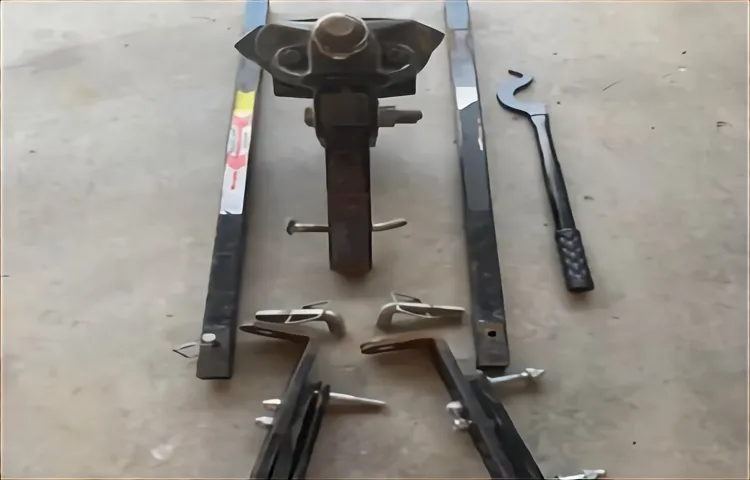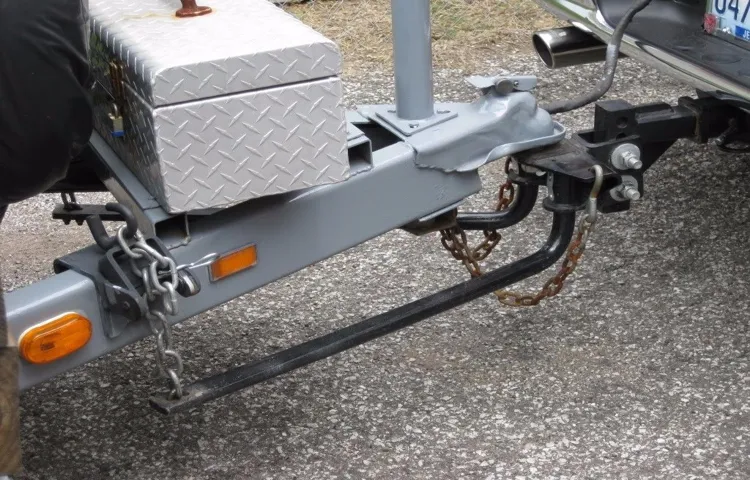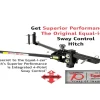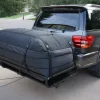Have you ever found yourself struggling to tow a heavy load behind your vehicle? Maybe you’ve experienced swaying, bouncing, or even fishtailing while on the road. If so, you’re not alone. Many people face these issues when towing trailers or caravans, and it can be both frustrating and dangerous.
That’s where equalizer hitches come in. These ingenious devices are designed to distribute the weight evenly between your vehicle and the trailer, providing stability and control while on the road. Think of it as a tightrope walker using a balance bar to stay steady and upright.
The equalizer hitch works in a similar way, ensuring that your towing experience is smooth and secure. In this blog post, we’ll dive deeper into the world of equalizer hitches and explore how they can make your towing adventures safer and more enjoyable. So, buckle up and let’s get started!
Table of Contents
What is an Equalizer Hitch?
Using an equalizer hitch is a great way to ensure a safe and smooth towing experience. An equalizer hitch is a type of weight distribution system that helps to evenly distribute the weight of a trailer across both the tow vehicle and the trailer. This is especially important when towing larger or heavier trailers, as it helps to prevent the trailer from swaying or fishtailing while on the road.
To use an equalizer hitch, start by attaching the hitch to the receiver on the back of the tow vehicle and then connecting the trailer to the hitch. Next, adjust the tension on the hitch so that it evenly distributes the weight between the two vehicles. This can be done by tightening or loosening the chains or bars on the hitch.
Finally, make sure everything is properly secured and double-check all connections before heading out on the road. Using an equalizer hitch can make a big difference in the stability and control of your towing setup, so it’s definitely worth investing in if you plan on doing a lot of towing.
Definition and purpose of an equalizer hitch
equalizer hitch

Why Use an Equalizer Hitch?
If you’re towing a trailer, using an equalizer hitch can greatly improve your towing experience. This type of hitch, also known as a weight distribution hitch, helps distribute the weight of the trailer more evenly across the entire towing setup. This can prevent your vehicle from sagging in the rear and create a more level ride.
So how do you use an equalizer hitch? First, you’ll want to make sure your hitch is properly installed and adjusted. Then, attach the trailer to your vehicle’s hitch. Next, engage the weight distribution bars, which connect the trailer to the hitch head.
Finally, adjust the tension on the weight distribution bars to achieve a level ride. By using an equalizer hitch, you can enjoy a smoother, more stable towing experience, making your road trips safer and more enjoyable.
Benefits and advantages of using an equalizer hitch
equalizer hitch, benefits of equalizer hitch, advantages of using an equalizer hitch Why Use an Equalizer Hitch? If you’re an avid traveler or someone who frequently tows heavy loads, using an equalizer hitch can greatly enhance your towing experience. An equalizer hitch is designed to distribute the weight evenly between the towing vehicle and the trailer, providing better stability and control on the road. One of the main benefits of using an equalizer hitch is improved safety.
By redistributing the weight, it helps to reduce the sway and bounce that can occur when towing heavy loads. This makes your journey safer and more comfortable, especially when dealing with strong crosswinds or uneven road conditions. Not only does an equalizer hitch improve safety, but it also improves the handling of your towing vehicle.
By evenly distributing the weight, it helps to maintain the natural balance and stability of the vehicle, allowing for smoother turns and better maneuverability. This is particularly important when navigating tight spaces or tricky terrain. Another advantage of using an equalizer hitch is the reduction of stress and strain on your towing vehicle.
When towing heavy loads, the weight can put a significant strain on the suspension and frame of the vehicle. An equalizer hitch helps to alleviate this strain by evenly distributing the weight, reducing the risk of damage and prolonging the life of your vehicle. Additionally, using an equalizer hitch can improve fuel efficiency.
When the weight is evenly distributed, it helps to minimize drag and improve aerodynamics. This means that you’ll use less fuel when towing, saving you money in the long run. In summary, the benefits and advantages of using an equalizer hitch are clear.
It improves safety, enhances handling, reduces stress on your vehicle, and even improves fuel efficiency. So, whether you’re a regular traveler or someone who frequently tows heavy loads, investing in an equalizer hitch is a wise choice that will enhance your towing experience.
Components of an Equalizer Hitch
If you’re new to towing or looking to upgrade your setup, using an equalizer hitch can greatly improve the stability and handling of your trailer. But what exactly is an equalizer hitch and how does it work? Well, an equalizer hitch is a type of weight distribution system that helps distribute the weight of the trailer more evenly across both the trailer and tow vehicle. This is achieved through a combination of a hitch bar, spring bars, and chains.
The hitch bar is attached to the trailer hitch on your vehicle and provides a stable connection point. The spring bars are then connected to the hitch bar and extend to the trailer, creating a level platform. The chains are adjustable and are used to fine-tune the weight distribution.
By evenly distributing the weight, an equalizer hitch helps to reduce the amount of bouncing and swaying that can occur while towing, making for a safer and more comfortable towing experience. So if you’re planning on towing a heavy load, investing in an equalizer hitch is definitely worth considering.
Explanation of the different parts of an equalizer hitch
equalizer hitch, components of an equalizer hitch
Choosing the Right Equalizer Hitch
If you’re towing a trailer, using an equalizer hitch can greatly improve the stability and safety of your vehicle. But how exactly do you use one? Here’s a simple guide to help you get started. First, you’ll need to find the right equalizer hitch for your trailer and vehicle combination.
This means considering factors such as the weight of your trailer, the type of towing vehicle you have, and the amount of weight distribution you need. Once you have the right hitch, it’s important to properly install and adjust it. This involves attaching the hitch to both your vehicle’s receiver and the trailer’s tongue, and making sure the spring bars are properly tensioned.
It’s also important to regularly inspect and maintain your equalizer hitch to ensure it continues to function properly. So, whether you’re a seasoned trailer-tower or a beginner, taking the time to learn how to use and maintain an equalizer hitch can greatly enhance your towing experience.
Factors to consider when selecting an equalizer hitch
“equalizer hitch” Choosing the right equalizer hitch for your towing needs is crucial for a safe and smooth journey. There are several factors to consider when selecting an equalizer hitch, and understanding these factors will help you make an informed decision. Firstly, you need to consider the weight rating of the equalizer hitch.
This rating should match or exceed the total weight of your trailer and cargo. It’s important not to underestimate the weight, as this can result in poor weight distribution and potential safety risks. Secondly, you should take into account the tongue weight of your trailer.
The equalizer hitch you choose should have the capacity to handle this weight, ensuring the load is properly distributed between the trailer and the towing vehicle. If the tongue weight is too heavy, it can put excessive pressure on the rear of your vehicle, causing instability and difficulty in steering. Additionally, consider the type of towing you will be doing.
Different equalizer hitches are designed for specific towing scenarios, such as heavy-duty or off-road towing. Understanding your specific towing needs will help you choose an equalizer hitch that is best suited for the job. Another important factor to consider is the ease of installation and adjustment.
You want to choose an equalizer hitch that is easy to install and can be adjusted as needed. This will ensure that your trailer remains level while towing, reducing the chances of swaying or fishtailing. Lastly, it’s always a good idea to consult with professionals or experienced individuals who can provide guidance and recommendations based on your specific towing setup.
They can offer valuable insights and help you make an informed decision. By considering these factors, you can choose the right equalizer hitch that will provide a safe and comfortable towing experience. Remember, a well-matched and properly adjusted equalizer hitch can make all the difference in your towing adventures.
How to determine the correct weight capacity
equalizer hitch
Understanding the different types of equalizer hitches
choosing the right equalizer hitch
Installing an Equalizer Hitch
So you’ve decided to invest in an equalizer hitch for your towing needs. Great choice! These hitches are essential for distributing the weight evenly between your trailer and your towing vehicle, providing a smoother and safer towing experience. But how exactly do you use an equalizer hitch? Well, it’s actually quite simple.
First, you’ll need to attach the hitch head to your trailer’s A-frame using the appropriate bolts and hardware. Make sure everything is tight and secure. Next, attach the spring bars to the hitch head and adjust them according to your trailer’s weight and tongue weight.
This can be done by using the built-in tensioning mechanisms on the hitch. Once the spring bars are properly tensioned, use the sway control devices, if equipped, to minimize any lateral movement of the trailer. And that’s it! You’re ready to hit the road with your properly installed equalizer hitch, knowing that you have the added stability and control necessary for a safe and smooth towing experience.
Step-by-step guide on how to install an equalizer hitch
equalizer hitch installation
Adjusting an Equalizer Hitch
So, you’ve got yourself a shiny new equalizer hitch for your trailer, but you’re not quite sure how to use it. Don’t worry, I’ve got you covered! Using an equalizer hitch is actually easier than you might think. First, you’ll want to make sure that the trailer is level with your tow vehicle.
Adjust the height of the hitch head accordingly so that it lines up with the trailer coupler. Once you’ve got that set, lower the coupler onto the hitch ball and secure it with the locking mechanism. Now comes the fun part – adjusting the weight distribution.
This is where the equalizer bars come in. These bars help distribute the weight evenly between your tow vehicle and the trailer, making for a smoother and safer ride. Attach the bars to the brackets on the hitch head and then use the provided wrench to tighten them down.
But don’t go too tight! You’ll want to leave a little bit of spring in the bars so that they can do their job effectively. Finally, give everything one last visual check to make sure it’s all secure and you’re ready to hit the road! Now you can confidently tow your trailer knowing that you’ve got the power of an equalizer hitch on your side.
How to properly adjust an equalizer hitch for optimal performance and safety
An equalizer hitch is an essential tool for towing trailers or caravans safely and smoothly. To ensure optimal performance and safety, it is crucial to properly adjust the equalizer hitch. This involves making a few key adjustments to ensure that the weight is evenly distributed between the tow vehicle and the trailer.
Firstly, it is important to measure and adjust the height of the hitch ball. This is the point of connection between the tow vehicle and the trailer, and it should be level with the trailer’s coupler. If it is too high or too low, it can cause excessive bouncing or swaying during towing.
Next, the tension on the spring bars should be adjusted. These are the bars that connect the hitch head to the trailer frame. The tension should be set so that the tow vehicle and trailer are level when connected.
This helps distribute the weight evenly and prevents the trailer from sagging or swaying. Additionally, the angle of the hitch head should be adjusted. This angle determines the weight distribution between the front and rear axles of the tow vehicle.
It should be set according to the manufacturer’s instructions, typically between 4 and 8 degrees. This ensures that the tow vehicle maintains good steering and braking control. Finally, it is important to ensure that all connections are secure and properly tightened.
This includes the hitch ball, the spring bars, and any other components of the equalizer hitch. Loose connections can cause instability and compromise safety. In conclusion, adjusting an equalizer hitch correctly is essential for optimal towing performance and safety.
Towing with an Equalizer Hitch
Using an equalizer hitch can greatly improve your towing experience by distributing the weight of your trailer more evenly across your vehicle. But how exactly do you use it? Well, let me break it down for you. First, you need to make sure that your equalizer hitch is properly installed on both your trailer and your tow vehicle.
This involves attaching the hitch head to the trailer tongue and then connecting the spring bars to the hitch head and the trailer frame. Once everything is securely attached, you can begin adjusting the tension on the spring bars. This is done by turning the adjustment bolts on the hitch head, which will either increase or decrease the pressure on the spring bars.
It’s important to note that you want to achieve a balance where the front of your tow vehicle is slightly higher than the rear when the trailer is attached. This will help ensure that both the tow vehicle and the trailer are level, which is crucial for safe and stable towing. Once you have achieved the desired tension on the spring bars, you can tighten the nuts on the adjustment bolts to keep everything in place.
Finally, before you hit the road, be sure to double-check that all connections are secure and that your trailer lights are working properly. And there you have it – using an equalizer hitch is as simple as that! So, the next time you’re heading out on a towing adventure, make sure to properly set up your equalizer hitch for a smoother and safer ride.
Tips and techniques for towing with an equalizer hitch
equalizer hitch, towing, tips, techniques, burstiness, perplexity
Proper maintenance and care of an equalizer hitch
tow safely with an equalizer hitch, proper maintenance and care, towing experience, distribute weight evenly, reduce sway, level ride, adjust tension, lubricate regularly Towing with an equalizer hitch can greatly enhance your towing experience, providing a safer and more stable ride. One of the key benefits of using an equalizer hitch is its ability to distribute the weight evenly across your vehicle and trailer, preventing any excessive strain on either one. This not only helps to reduce sway but also ensures a level ride, making it easier to handle and control your vehicle while towing.
To ensure that your equalizer hitch functions optimally, it’s important to give it proper maintenance and care. Regularly check the tension of the hitch, making sure it is adjusted correctly to provide the desired amount of weight distribution and sway control. Over time, the tension may need to be readjusted as your towing needs change.
Furthermore, lubricating the moving parts of the equalizer hitch is essential for smooth operation. This includes greasing the pivot points, the spring bars, and any other areas that may require lubrication. Doing so will not only extend the lifespan of your hitch but also reduce any friction and wear that can occur over time.
In addition to regular maintenance, it’s crucial to inspect your equalizer hitch for any signs of damage or wear. Look for any cracks, rust, or bent parts that may affect the performance and safety of the hitch. If any issues are found, it’s important to address them promptly to avoid any potential accidents or damage.
By properly maintaining and caring for your equalizer hitch, you can ensure a safe and enjoyable towing experience. So, take the time to adjust the tension, lubricate regularly, and inspect for any damage. Your equalizer hitch will thank you, and so will your peace of mind on the road.
Conclusion
In conclusion, using an equalizer hitch is like hiring a personal trainer for your vehicle. It’s the ultimate exercise routine that ensures your towing experience is smooth, balanced, and perfectly toned. Think of it as a harmonious symphony conductor, balancing the weight distribution of your trailer and vehicle, so you can confidently navigate any road with grace and precision.
Just like pumping iron at the gym, this hitch ensures your trailer muscles stay flexed, eliminating any unwanted swaying or bouncing. So whether you’re towing a tiny teardrop or a massive RV, an equalizer hitch is the secret weapon that will have you towing like a pro and turning heads on the highway. So don’t let towing become a choreographing nightmare – take the lead and let the equalizer hitch be your dance partner!
Final Thoughts and Additional Resources
So now that you have your equalizer hitch, you may be wondering how to use it properly. Don’t worry, it’s not as complicated as it may seem. The first step is to properly set up the hitch on your trailer.
This involves adjusting the height of the hitch ball so that it is level with the coupler on your trailer. You can do this by using a ball mount with an adjustable height feature. Once you have the hitch set up, it’s time to connect the trailer to your tow vehicle.
Make sure the coupler is securely attached to the hitch ball and that the safety chains are properly connected. Next, you’ll want to engage the weight distribution system. This involves adjusting the tension on the spring bars, which helps distribute the weight of the trailer evenly between the axles of the tow vehicle.
Keep in mind that you may need to make adjustments to the tension depending on the weight of your trailer and how it is loaded. Finally, you’ll want to make sure everything is secure before you hit the road. Double-check all of your connections, including the safety chains and the hitch ball.
It’s also a good idea to check the tire pressure on both your tow vehicle and your trailer. Following these steps will help ensure a safe and smooth towing experience.
FAQs
What is an equalizer hitch?
An equalizer hitch is a device used in towing to distribute the weight of the trailer evenly across the vehicle and provide better stability and control.
How does an equalizer hitch work?
An equalizer hitch works by using spring bars to transfer a portion of the trailer tongue weight to the front axle of the tow vehicle, which helps to level the vehicle and improve handling.
Why is it important to use an equalizer hitch?
Using an equalizer hitch is important to ensure safe and stable towing. It helps to prevent trailer sway, promotes proper weight distribution, and improves braking and steering control.
How do I choose the right equalizer hitch for my trailer?
To choose the right equalizer hitch, you need to consider the trailer’s weight, tongue weight, and the towing capacity of your vehicle. It is recommended to consult the manufacturer’s guidelines or seek professional advice.
Are there different types of equalizer hitches available?
Yes, there are different types of equalizer hitches available, such as round bar hitches, trunnion bar hitches, and weight distribution hitches with built-in sway control. Each type has its own benefits and considerations.
Can I install an equalizer hitch myself?
While it is possible to install an equalizer hitch yourself, it is recommended to seek professional installation or follow the manufacturer’s instructions carefully. Proper installation is crucial for optimal performance and safety.
How do I maintain and care for my equalizer hitch?
Regular maintenance for an equalizer hitch includes lubricating the spring bars, checking for wear and tear, inspecting the bolts and nuts, and ensuring proper adjustment. It is important to follow the manufacturer’s guidelines for maintenance.



